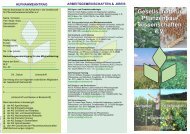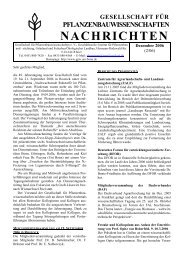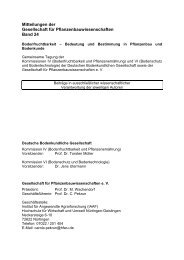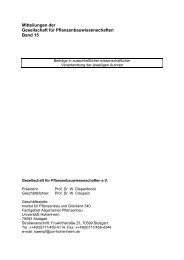Mitteilungen der Gesellschaft für Pflanzenbauwissenschaften Band 23
Mitteilungen der Gesellschaft für Pflanzenbauwissenschaften Band 23
Mitteilungen der Gesellschaft für Pflanzenbauwissenschaften Band 23
Sie wollen auch ein ePaper? Erhöhen Sie die Reichweite Ihrer Titel.
YUMPU macht aus Druck-PDFs automatisch weboptimierte ePaper, die Google liebt.
Mitt. Ges. Pflanzenbauwiss. <strong>23</strong>: 67–68 (2011)<br />
Auxin-mediated ammonium toxicity in Arabidopsis roots<br />
Huaiyu Yang, Jenny von <strong>der</strong> Fecht-Bartenbach and Uwe Ludewig<br />
Institute of Crop Science, Nutritional Crop Physiology, University of Hohenheim, Stuttgart. E-Mail:<br />
u.ludewig@uni-hohenheim.de<br />
Introduction<br />
Most plant species prefer the combined nutrition of NO3- and NH4 + , and suffer when<br />
ammonium (the sum of NH4 + and NH3) is the predominant or exclusive mineral nitrogen<br />
(N) source. Stunted root and shoot growth, reduced photosynthetic activity, and<br />
in extreme cases chlorosis of leaves, are typical visible symptoms of so-called<br />
ammonium toxicity. Reduced cation uptake results in mineral nutrient deficiencies of<br />
K + , Mg2 + and Ca2 + and leads to a lowered osmotic potential and finally reduced water<br />
uptake. High K + alleviated toxicity by inhibition of NH4 + uptake and stimulated carbon<br />
and nitrogen assimilation in the roots. Plants can detoxify excess ammonium at least<br />
to some extent metabolically, e.g. by glutamine synthetase (GS) or endogenous<br />
glutamate dehydrogenase (GDH). With ammonium nutrition, excess protons need to<br />
be excreted into the soil, which acidifies the rhizosphere and reduces root expansion,<br />
a phenotype that can partially be suppressed by buffering the root medium.<br />
Nutritional and cellular imbalances are integrated via plant hormones, such as<br />
auxin and cytokinin, and the growth regulation by these hormones ultimately shape<br />
roots and shoots. Auxin synthesis and distribution within the plant is mediated by a<br />
complex transport network; the decrease in auxin at the root tips altered cell growth<br />
and elongation. Previous reports identified connections of the root development with<br />
its nitrate status, which may be integrated with the auxin concentration in the roots.<br />
The root growth inhibition of maize by high nitrate involved reduced endogenous<br />
auxin and enhanced cytokinin in root tips.<br />
To investigate the growth defects associated with ammonium nutrition, a transcriptome<br />
analysis and genetic approach was carried out with Arabidopsis seedlings. This<br />
analysis confirmed many well-known physiological changes associated with<br />
ammonium nutrition and identified novel links to cell wall metabolism and suggest an<br />
altered control of root growth by auxin in ammonium stress that can be partially<br />
overcome by mutants in the auxin distribution.<br />
Material and Methods<br />
Arabidopsis thaliana was grown with buffered 3 mM NH4SO4, 6 mM KNO3 or 1.5 mM<br />
NH4NO3 as the nitrogen forms, RNA was isolated and microarray analysis with ATH1<br />
chips was done. The expression estimates and statistical analysis used the rank<br />
product method and the mapman software. Mutant seeds included the auxin-related<br />
mutants rcn1, 35S::PID, DR5::GUS, aux1 and pin2.<br />
Results and Discussion<br />
As expected from the similar plant growth, there were only minor differences in the<br />
transcriptome of plants grown on NH4NO3 and NO3 - . The cluster analysis suggested<br />
that the primary and secondary metabolism, protein biosynthesis and degradation<br />
pathways slightly differed between these conditions. These minor changes were in<br />
accordance with the mo<strong>der</strong>ately altered amino acid profile and the different<br />
ammonium content. By contrast, the ammonium content, amino acid and<br />
transcriptional profile were markedly changed with pure NH4 + nutrition. A Rank







